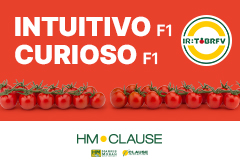There is a consolidated production in three of the European distribution of apple varieties (Golden, Gala and Idared), although with different future trends.
As can be deduced from the statistical work by Freshfel, since 2007 the Gala apple has held a clearly positive trend, with a 26% increase and over 1,250,000 tonnes in 2016. The other variety that benefits most is the Idared, with a 19% rise and over one million tonnes produced.
The Golden variety, the only one that has always had a production of over 2,000,000 tonnes, for the same period has recorded more fluctuations and it has been losing steam since 2014, with a production of below 2.5 million tonnes. In spite of everything, it is still the European star, although there are important possibilities of it having to share its success with other varieties in the future.
On the smaller production range, between 500,000 and 600,000 tonnes, there are two groups: the Red Delicious and Jonagold on the one hand, and Jonagored and Shampion on the other. The former belongs to the losing category, due to the fact that since 2007 its production has dropped in Europe. Specifically, Red Delicious has decreased by 17% and Jonagold by 36%. On the other hand, the winners are Jonagored, with a 31% increase, and Shampion, with the most spectacular increase of 170%. However, Philippe Binard, secretary general of Freshfel, has doubts about Shampion’s disproportionate increase, “an apple that could be very interesting in Poland and on its markets, but in which there is no interest in other places.” The same could also happen with Jonagored, which has great acceptance in Benelux and Germany.
Within the range of 250,000 to 400,000 tonnes of product, there are different varieties, with only one that has dropped, Elstar (-16%), and highly significant increases in Cripps Pink, which has grown by 271%; Fuji with a 50% increase and Braeburn, with 10%.
“Overall, it should be pointed out that in these harvest forecasts there is a group of other varieties that represents 1.8 million tonnes that do not appear in the statistics (they are mainly local), but which make up almost 8% of the total, as well as another 530,000 tonnes of new varieties or some club varieties,” the executive qualifies, whilst at the same time demanding greater transparency in the data.
Exports. In just a decade, Europe has moved from being a net apple importer to an exporter continent. In 2005, imports from the Old Continent were virtually reaching one million tonnes and a decade later, these only reach 450,000 tonnes. On the other side of the balance, we find that exports in 2005 were around 700,000 tonnes and ten years later, sales outside the E.U. have grown by a million tonnes and now reach the figure of 1,700,000.
With this information in hand, it is almost certain that the sector must make some serious decisions about where its future expectations are headed. As Herbert Dorfmann, the European M.P. for South Tyrol stated, “apple exporters must look outside Europe’s borders.”
On this same point Binard also comments that “Europe must remain alert because after the Russian disaster, the second most important destination could have problems, since Algeria is working under protectionist policies; Libya has virtually disappeared as a market and Egypt has economic problems. Only Morocco continues with its normal demand.
























